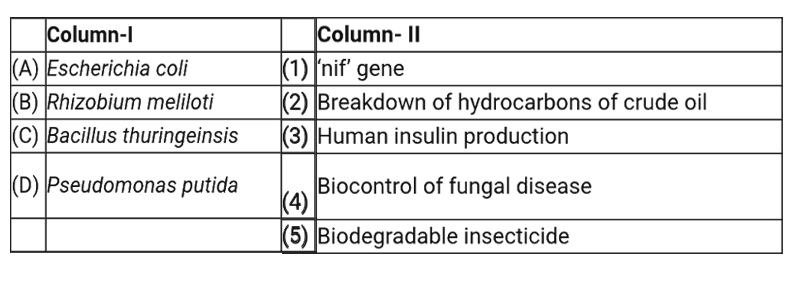Which of the following functions from A→B are one-one and onto? f1={(1,3),(2,5),(3,7)};A={1,2,3},B={3,5,7} f2={(2,a),(3,b),(4,c)};A={2,3,4},B={a,b,c} f3={(a,x),(b,x),(c,z),(d,z)};A={a,b,c,d},B={x,y,z}
To determine which of the given functions from set A to set B are one-one (injective) and onto (surjective), we will analyze each function step by step.
Step 1: Analyze Function f1
Given:
- f1={(1,3),(2,5),(3,7)}
- A={1,2,3}
- B={3,5,7}
Check if f1 is one-one:
- A function is one-one if no two different elements in A map to the same element in B.
- Here, f1(1)=3, f1(2)=5, f1(3)=7.
- All outputs are distinct. Therefore, f1 is one-one.
Check if f1 is onto:
- A function is onto if every element in B is mapped by some element in A.
- The elements in B are 3,5,7 and all are covered by f1.
- Therefore, f1 is onto.
Conclusion for f1:
- f1 is both one-one and onto.
Step 2: Analyze Function f2
Given:
- f2={(2,a),(3,b),(4,c)}
- A={2,3,4}
- B={a,b,c}
Check if f2 is one-one:
- Here, f2(2)=a, f2(3)=b, f2(4)=c.
- All outputs are distinct. Therefore, f2 is one-one.
Check if f2 is onto:
- The elements in B are a,b,c and all are covered by f2.
- Therefore, f2 is onto.
Conclusion for f2:
- f2 is both one-one and onto.
Step 3: Analyze Function f3
Given:
- f3={(a,x),(b,x),(c,z),(d,z)}
- A={a,b,c,d}
- B={x,y,z}
Check if f3 is one-one:
- Here, f3(a)=x, f3(b)=x, f3(c)=z, f3(d)=z.
- The elements a and b both map to x, and c and d both map to z.
- Therefore, f3 is not one-one.
Check if f3 is onto:
- The elements in B are x,y,z.
- The element y is not covered by f3.
- Therefore, f3 is not onto.
Conclusion for f3:
- f3 is neither one-one nor onto.
Final Conclusion
- Functions f1 and f2 are both one-one and onto.
- Function f3 is neither one-one nor onto.
Given:
- f1={(1,3),(2,5),(3,7)}
- A={1,2,3}
- B={3,5,7}
- A function is one-one if no two different elements in A map to the same element in B.
- Here, f1(1)=3, f1(2)=5, f1(3)=7.
- All outputs are distinct. Therefore, f1 is one-one.
- A function is onto if every element in B is mapped by some element in A.
- The elements in B are 3,5,7 and all are covered by f1.
- Therefore, f1 is onto.
- f1 is both one-one and onto.
Given:
- f2={(2,a),(3,b),(4,c)}
- A={2,3,4}
- B={a,b,c}
- Here, f2(2)=a, f2(3)=b, f2(4)=c.
- All outputs are distinct. Therefore, f2 is one-one.
- The elements in B are a,b,c and all are covered by f2.
- Therefore, f2 is onto.
- f2 is both one-one and onto.
Given:
- f3={(a,x),(b,x),(c,z),(d,z)}
- A={a,b,c,d}
- B={x,y,z}
- Here, f3(a)=x, f3(b)=x, f3(c)=z, f3(d)=z.
- The elements a and b both map to x, and c and d both map to z.
- Therefore, f3 is not one-one.
- The elements in B are x,y,z.
- The element y is not covered by f3.
- Therefore, f3 is not onto.
- f3 is neither one-one nor onto.
- Functions f1 and f2 are both one-one and onto.
- Function f3 is neither one-one nor onto.
Topper's Solved these Questions
Similar Questions
Which of the following functions from A to B are one-one and onto? f1={(1, 3), (2, 5), (3, 7)}; A={1, 2, 3}, B={3, 5, 7} (ii) f2={(2, a), (3, b), (4, c)}; A={2, 3, 4}, B={a, b, c} (iii) f3={(a, x), (b, x), (c, z), (d, z)}; A={a, b, c, d}, B={x,y, z}
View SolutionMatch the following and choose the correct combination from the options given :

(a) ABCD3154
(b) ABCD1234
(c) ABCD2134
(d) ABCD3152
View SolutionIf A={1,2,3}, B={1,2,3,4}, C={4,5,6}, find :A×(B∩C)
View SolutionIf x = 6a + 8b + 9c, y = 2b - 3a - 6c and z = c - b + 3a, find :
x+y+z
View SolutionAdd the following: x−3y−2z (ii) 4ab−5bc+7ca
View SolutionLet A={1,2,3},B=4,5,6,7} and let f={(1,4),(2,5),(3,6)} be a function from A to B. Show that f is one - one but not onto.
View SolutionIf ⎡⎢⎣x+3z+42y−74x+6a−10b−33bz+2c⎤⎥⎦=⎡⎢⎣063y−22x−32c+22b+4−210⎤⎥⎦ Obtain the values of a, b, c, x, y and z .
View SolutionIf x = 6a + 8b + 9c, y = 2b - 3a - 6c and z = c - b + 3a, find :
x−y+z
View SolutionLet A={1,2,3}, B={4,5,6,7} and let f={(1,4), (2,5), (3,6)} be a function from A to B . State whether f is one-one or not.
View SolutionIf x = 6a + 8b + 9c, y = 2b - 3a - 6c and z = c - b + 3a, find :
3y−2z−5x
View Solution
